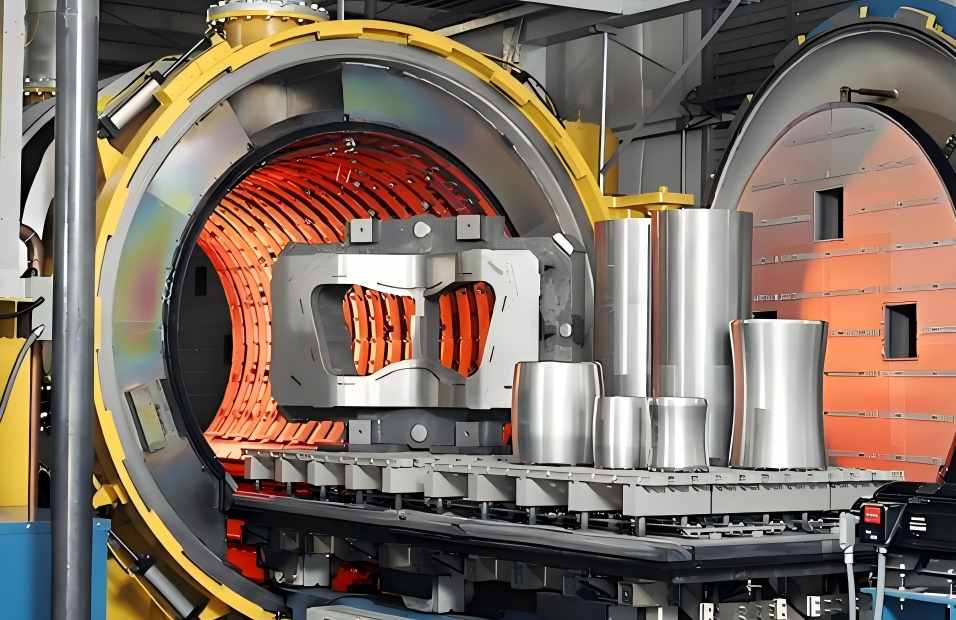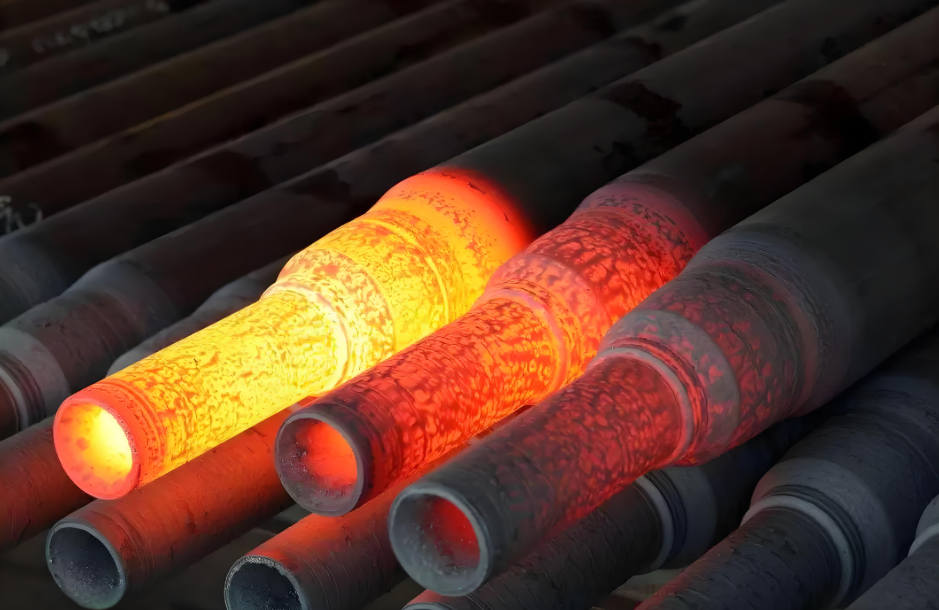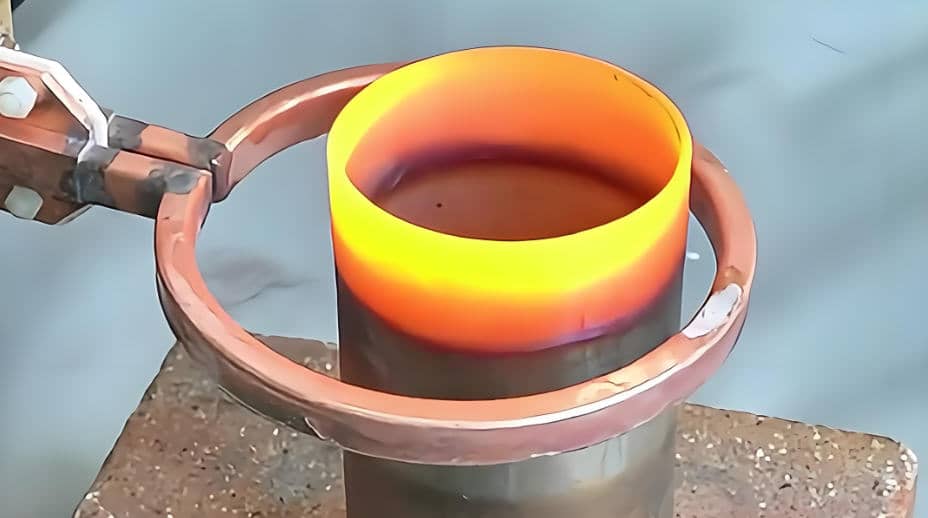
The benefits of the heat treatment for metal spinning
What is heating treatment

Heat treatment is a common process method in manufacturing. It refers to a processing method that changes the internal structure of metallic or non-metallic materials in the solid state through processes such as heating, holding at temperature, and cooling, thereby achieving the expected performance.
The core lies in controlling temperature parameters to trigger material phase transitions (such as austenitizing, martensitic transformation, etc.), and thereby adjusting mechanical properties such as hardness, strength, and toughness.
Metal spinning> industry also frequently employs heat treatment. This article will focus on introducing some techniques and processing methods related to spinning and heat treatment.
Mold and roller quenching
There are mainly three types of materials for the molds used in metal spinning. 45 # steel is used for spinning aluminum, 40Cr for spinning steel, and Cr12 for spinning stainless steel. The ones that most often require heat treatment are 40Cr and Cr12. After the rough turning of the mold is completed, quenching is carried out to enhance the hardness of the mold steel, thereby improving the hardness and wear resistance of the mold.
The spinning roller requires a higher hardness than the mold. It is usually quenched with Cr12mov material, with an HRC hardness of over 58 degrees.
Material annealing
1. Aluminum annealing
Aluminum alloy annealing is a heat treatment process that softens the material and eliminates stress through heating and holding at temperature. It mainly includes the following types and key points of the process .
The most commonly used aluminium alloy in the market is in the T6 state, with HB hardness of 90-95. We call it the hard state commonly and it is often used for CNC turning and milling. Because aluminium is too soft, it will cause the tool to stick and the surface finish will not be smooth. However, metal spinning requires the use of a soft state (O state). The soft state has good ductility and low hardness. If hard state aluminum is used for spinning, the workpiece will break very soon.
The most commonly sold aluminum by suppliers in the market is T6. Therefore, when you purchase aluminum materials, it is best to inform them that you need O-state aluminum alloy for metal forming to avoid purchasing the wrong aluminum materials and causing losses to the factory. In addition, many aluminum alloy grades do not have O-state materials when the quantity is small and need to be customized in large quantities. In such cases of sample making or small batch production, you can only purchase T6 state and then use the annealing process to transform the T6 aluminum alloy into O-state.
2. Stainless steel tube annealing
Stainless steel pipes are often used for pipe spinning. However, many stainless steel pipes on the market are used for stairs, water pipes, decoration and other purposes. When they are used for spinning, they may break due to insufficient ductility of the material. Stainless steel pipes need to be custom-made. The raw material of stainless steel must be 304L, and the grade is DDQ, which means deep drawing quality. Welding requires automatic laser welding or argon welding, and the position of the weld seam is less likely to break during the spinning process.
When we need to make tube spinning samples, due to the small quantity, we can first purchase standard tubes from the market. Through annealing treatment, the weld position can be softened. After annealing, the ductility of stainless steel tubes during the spinning process is still not as good as that of DDQ material tubes. At this time, we can appropriately heat during the tube spinning process to reduce the hardening during the cold working process. Improve the forming capacity of stainless steel pipes.
Stress Relieving of spun metal product

After the spun products are extruded by the roller, internal stress will be generated in the material. The uneven internal stress will cause a certain degree of ellipticity in the product. To reduce the influence of internal stress on the product's dimensions, stress relieving can be achieved through heat treatment. However, after stress relief, both the hardness and tensile strength of the material will decrease.
1. The influence of internal stress on CNC turning
The precision of CNC lathes is very high. When many people are making processing plans, for some products, they can first spin to make the wall thickness thicker, and then use CNC lathes for precision turning to achieve better dimensional accuracy. Many people overlook two issues. First, the internal stress of the product after spinning can cause thin-walled parts to deform. Even though the precision of turning is very high, when you remove the part from the fixture, the internal stress will still cause the product to undergo secondary deformation. Therefore, before fine processing with a CNC lathe, it is necessary to relieve the stress on the spun products. Secondly, spun products are thin-walled parts. The reasonable design of the turning fixture is very important. If three-jaw clamping is used, the uneven clamping force will cause local deformation of the product or large clamping runout. At the same time, if there is no uniform clamping force on the inner or outer wall of the spun product, it is very easy to cause tool vibration during turning.
2. Welding internal stress
● Spinning metal part welding ways
All spun parts are thin-walled parts. When they undergo welding processes, the welding stress will cause significant deformation of the products. To reduce welding deformation, it is necessary to design a reasonable fixture to support the spun parts. At the same time, it is also necessary to ensure that the parts tightly wrap around the fixture during welding shrinkage. Therefore, demolding design is also an important consideration factor. After the parts are welded, they should be allowed to cool down completely on the fixture before being removed to achieve better accuracy.
The best welding methods for spun parts are argon arc welding and laser welding. During welding, the input of heat needs to be controlled to reduce welding stress deformation. Thick spun products can be welded by argon arc welding, while thin spun products should be welded by laser welding.
● Welding stress relief
After the parts are welded, vacuum heat treatment can be used for stress relief. Vacuum heat treatment has less stress relief deformation and the surface does not turn black. The surface of the furnace used in traditional mold heat treatment is prone to black skin, which affects the appearance of the parts. The oxide scale on the surface is difficult to grind and clean thoroughly.
Aluminum aging
When we need it, we usually use the O-state material, which is the softest state of aluminum. Spinning forming can increase the hardness of materials to around T3. If the hardness of the spun parts is to reach T6, heat treatment and aging can be carried out to achieve the required hardness of the spun products by the customers.
Stainless steel Stress Relieving
When process deep drawing of stainless steel, if the height of the spun product exceeds 200 mm that the shape is a straight cylinder, the workpiece directly formed by spinning will break due to multiple extrusion fatigue of the multiple spinning tool paths. The best way is to first use hydroforming to form a deep drawing blank, and then use heat treatment to relieve stress on the deep drawing blank to make it soft. The commonly used high-frequency method is to relieve stress on the deep drawing blank. This way, the production efficiency is higher.

Recommended
- -Top twelve metal forming fabrication methods
2025-11-22 - -What is CNC metal spinning machine tool
2024-08-15 - -Aerospace components-Precision manufacturing of CNC spinning
2025-01-29 - -Metal spun products - what product spin forming can do
2025-01-24 - -How to design a CNC metal spinning mold | mandrel
2024-04-12 - -Metal spinning materials
2024-04-14 - -Metal spinning development and prospect
2024-10-31 - -How to choose a CNC metal spinning machine
2024-04-18 - -Metal spinning process and technology
2024-11-30 - -How to control the accuracy of CNC metal spinning
2024-07-27
